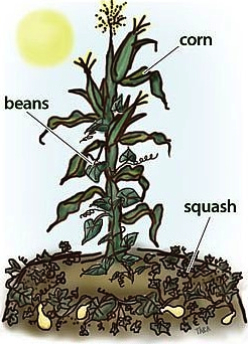Three Sisters Garden: A Class Gitigaan
This lesson is co-taught by 2 elders in the community that are master gardeners. They teach us about a three sister garden, seed collection and trade, and growing cycles.This lesson uses the book "The Good Path" by Thomas Peacock, to offer a perspective on the foods and sustainable resources used by Native Peoples of the past and present.We also briefly discuss ideas of food traditions and share meals and recipes that have been passed down through our elders.
Materials Needed
Resources

Art Materials
- Colored pencils and paper for illustrating the class feast
Documents
Activity Process
Motivation:
Students are introduced to two Elders in the community who propose they grow a "three sisters" garden on school grounds. We will call it our Urban Garden.
Demonstration:
We talk about food today and the foods we eat that are grown in our community versus foods that are not grown where we live. The differences in what and how we eat in a contemporary world. We also discuss the differences in traditional uses of foods- holiday dishes, celebration meals- how we use food to express events in life, and how food is illustrated through time in our stories, pictures and traditions.The elders lay out some of the seeds they harvested from last years crops. All neatly packaged in clear baggies and labeled various types of beans, corn and squash. The seeds are all different colors, sizes and shapes. The students appear mesmerized by the fact that these are the beginning of our food.
Activity:
- Students listen while the elders talk about the basics of gardening and the pleasures as well as the annoyances that come along with growing food.
- Students gather around the table and ask the elder questions about growing food. Mostly they ask about the biggest tomato they've grown, or the tallest corn. The elders have pictures to prove their stories!
- Students talk with the elders about what a 3 sisters garden is and why it is important; it consists of corn in the middle, beans around the corn to use as a trellis and squash around the beans, in order for it to have lots of room to vine around and tangle the bunny feet as they try to eat the beans.
- Students with the elders help scope out the best planting place on the school property and begin to plan for planting.
- The students prepare the ground, till and weed the sapce.
- Together we all plant and water diligently.
- Students journaled and recorded the growth of their plants weekly and drew pictures of the sprouts as they grew. They also hypothesized about part of the growth cycle and what they anticipate seeing next.
- Students also journaled about how their foods are passed down through the family? what did we learn to make from our elders? What food memories do we have when we think of home? 6. We harvest our crops and eat a class feast, after collecting the seeds to plant for next year.
Closure:
Students label their journal drawings with the plant parts and detail their observations through the process of growth. Students decide which drawing or set of drawings they want to exhibit and we put them on display in the commons area, with pictures of our crops and garden.
Checks:
Student drawings should demonstrate that they can identify plant parts and growing cycles.
Vocabulary Words
- Bakade (Hungry)
- Gichi-aya'aa (Elder, adult)
- Gitigaan (Garden)
- Gitigaanens (Vegetable)
- Mandaamin (Corn)
- Miskodiisimin(ag) (Bean(s))
- Niibin (Summer)
- Ogwisimaan (Pumpkin)
- Waawiyeyaa (Round, circlular)
- Wiikonge (Feast)
